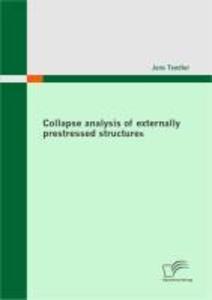Bücher versandkostenfrei*100 Tage RückgaberechtAbholung in der Wunschfiliale

Sofort lieferbar (Download)
The use of external prestressing is becoming more popular throughout Europe due to their expected higher durability and the possibility of active maintenance of the prestressing cables. Questions have been raised about the behaviour of these structures beyond service loads.
A comprehensive numerical analysis has been carried out comparing the behaviour of three different types of externally prestressed bridges to a conventionally internally prestressed bridge. The external types are a monolithically built bridge with external tendons, a monolithically built bridge with external tendons and blocked deviators, and a precast segmental bridge with external tendons. The internally prestressed bridge is monolithic. The primary objectives are to determine whether or not ductile failure occurs, i.e. the load-deflection response, and the tendon stress increase at ultimate stage.
The results show that the monolithically built bridges have a considerable higher ultimate moment capacity as well as deflection. This shows the advantage of using continuous ordinary reinforcement. All externally prestressed types did not reach the capacities of the internally prestressed bridge. It was found that ductility depends mostly on the reinforcement within the cross-section. Externally prestressed girders have no prestressing cables in the cross-section and need sufficient ordinary reinforcement in order to deform ductile. Although the tendon stress increase up to failure in the actual analysis is remarkable, the discussion shows that the magnitude varies greatly depending on the layout of the whole structure.
A comprehensive numerical analysis has been carried out comparing the behaviour of three different types of externally prestressed bridges to a conventionally internally prestressed bridge. The external types are a monolithically built bridge with external tendons, a monolithically built bridge with external tendons and blocked deviators, and a precast segmental bridge with external tendons. The internally prestressed bridge is monolithic. The primary objectives are to determine whether or not ductile failure occurs, i.e. the load-deflection response, and the tendon stress increase at ultimate stage.
The results show that the monolithically built bridges have a considerable higher ultimate moment capacity as well as deflection. This shows the advantage of using continuous ordinary reinforcement. All externally prestressed types did not reach the capacities of the internally prestressed bridge. It was found that ductility depends mostly on the reinforcement within the cross-section. Externally prestressed girders have no prestressing cables in the cross-section and need sufficient ordinary reinforcement in order to deform ductile. Although the tendon stress increase up to failure in the actual analysis is remarkable, the discussion shows that the magnitude varies greatly depending on the layout of the whole structure.
Inhaltsverzeichnis
1;Collapse analysis of externally prestressed structures;1 1.1;Abstract;3 1.2;Contents at a Glance;5 1.3;Contents;6 1.4;Acknowledgements;8 1.5;Notation;9 1.6;1 Introduction;12 1.6.1;1.1 Definitions;12 1.6.2;1.2 Significance of this study;14 1.6.3;1.3 Scope of the project;16 1.6.4;1.4 Historical overview and typical characteristics of external prestressing;17 1.6.5;1.5 Further structural applications of external prestressing;20 1.7;2 Behaviour of externally prestressed structures;21 1.7.1;2.1 Tendon layout considerations;21 1.7.2;2.2 Behaviour at serviceability stage;23 1.7.3;2.3 Fatigue problems;25 1.7.4;2.4 Behaviour at ultimate limit stage;25 1.7.4.1;2.4.1 Influence of tendon slip on the ultimate limit state;29 1.7.4.2;2.4.2 Influence of the arrangement of the deviators on the behaviourat ultimate limit state;30 1.7.4.3;2.4.3 Influence of simply support and continuous support on theultimate limit state;31 1.7.4.4;2.4.4 Precast segmental and monolithic bridges;32 1.8;3 Collapse analysis;34 1.8.1;3.1 Investigated bridge types and their differences;34 1.8.2;3.2 Original bridge data;39 1.8.3;3.3 Simplified bridge data as basis for the calculations;41 1.8.4;3.4 FE Calculation;43 1.8.4.1;3.4.1 Technical aspects;44 1.8.4.2;3.4.2 General approach;45 1.8.4.3;3.4.3 Geometric model;50 1.8.4.4;3.4.4 Element specifications;51 1.8.4.5;3.4.5 Constitutive models;56 1.8.4.6;3.4.6 Ordinary reinforcement;70 1.8.4.7;3.4.7 Prestress;71 1.8.4.8;3.4.8 Material and geometric non-linearity;74 1.8.4.9;3.4.9 Kinematic constraints;77 1.8.4.10;3.4.10 Discrete crack propagation analysis of the precastsegmental type with gap elements;79 1.8.4.11;3.4.11 Summary of the dividing features of the different structure types for the FE analysis;83 1.9;4 Results;84 1.9.1;4.1 Load deflection behaviour;84 1.9.2;4.2 Tendon stress increase up to failure;87 1.9.3;4.3 Other results;89 1.10;5 Discussion of the results;96 1.10.1;5.1 Interpretation of the results;96 1.10.2;5.2 Discussion of the exactness of the
FE calculations by comparing to the full scale test;100 1.10.3;5.3 Comparison to other FE calculations and test results;104 1.11;6 Conclusion and Recommendations;109 1.11.1;6.1 Concluding remarks;109 1.11.2;6.2 Recommendations;110 1.12;References;111 1.13;Codes of practice;117 1.14;Appendix;118
FE calculations by comparing to the full scale test;100 1.10.3;5.3 Comparison to other FE calculations and test results;104 1.11;6 Conclusion and Recommendations;109 1.11.1;6.1 Concluding remarks;109 1.11.2;6.2 Recommendations;110 1.12;References;111 1.13;Codes of practice;117 1.14;Appendix;118
Produktdetails
Erscheinungsdatum
01. September 2009
Sprache
englisch
Seitenanzahl
158
Dateigröße
5,76 MB
Autor/Autorin
Jens Tandler
Verlag/Hersteller
Kopierschutz
ohne Kopierschutz
Family Sharing
Ja
Format
EBOOK
Dateiformat
PDF
ISBN
9783836622981
Entdecken Sie mehr
Bewertungen
0 Bewertungen
Es wurden noch keine Bewertungen abgegeben. Schreiben Sie die erste Bewertung zu "Collapse analysis of externally prestressed structures" und helfen Sie damit anderen bei der Kaufentscheidung.









